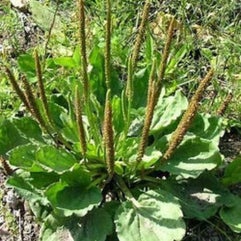
You have walked on this plant hundreds of times. Maybe even hit it with weedkiller. But little did you know, the Broadleaf Plantain is one of the most potent medicinal plants found in your backyard.
An effective wound healer, Broadleaf Plantain is anti-microbial, anti-inflammatory, and among other uses, is being studied for its anti-cancerous properties.
And, you can eat it in a salad! It tastes slightly bitter like spinach and the flower stalks have an asparagus flavor
Fast Facts
- Broadleaf Plantain originated in Eurasia and was brought to the United States by the early settlers.
- Known by Native Americans as "White Man's Footprint", because it grew in areas that were heavily traveled by the early settlers.
- A single plant can create between 14,000 and 20,000 seeds per year. The seeds can last in the ground for up to 60 years before sprouting.
- Although it is not native to Indiana, it is not considered a nuisance plant as it serves some benefits to the environment.
- Earliest uses for Broadleaf Plantain were for wound healing and as a food source.
Identification
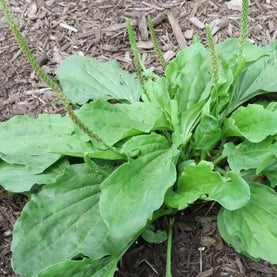
Where to Find it
Broadleaf Plantain can be found anywhere, but mostly in areas that are frequently traveled. Although it is very adaptable to any soil, it prefers compact, nutrient-rich soils.
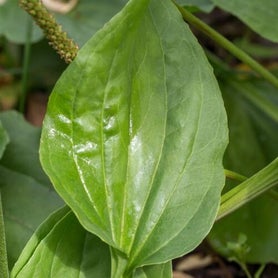
Leaves
Broadleaf Plantain can be identified by its rosettes of spirally arranged leaves. The leaves are flat, broad, and oval-shaped. They can grow quite large, ranging from 6-12 inches long and approximately 1-4 inches wide. It will have 5-9 veins that run the length of the leaf, and the base of the leaf will have a reddish-purple hue. If you break a leaf in half, it will have a stringy appearance, much like celery.
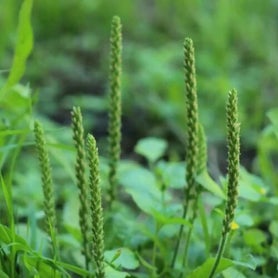
Flower Stalk
The flower stalk grows from the center of the plant and ranges from 2 to 6 inches tall or taller. The flowers range in color from green to brown.
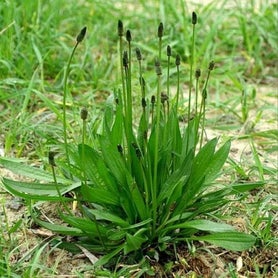
DANGEROUS LOOK-ALIKES
Because there are no known dangerous look-alikes, the Broadleaf Plantain is a great beginner plant. There are, however, many species of plantain, and you have probably seen the one pictured in your yard as well. This is the Ribwort Plantain, and it can be used in the same ways as the Broadleaf Plantain.
Harvesting and Drying
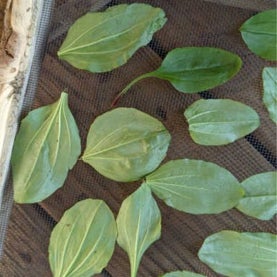
Broadleaf Plantain can be harvested from early Spring to late Fall. Always harvest leaves from areas that have not been sprayed with herbicides or have been used by pets.
ALWAYS THOROUGHLY WASH AND DRY THE LEAVES BEFORE USE
For eating in salads, harvest the leaves in early Spring when they are young and tender. When harvesting leaves from late Spring through Fall, cook them to make them easier to eat.
You can either air dry or use a dehydrator to dry your Broadleaf Plantain. To air dry, spread leaves in a single layer on a drying screen, paper towel, or dish towel until dry. Or you can use a dehydrator set on a low setting (around 90 degrees Fahrenheit).
Storing

Once your leaves are thoroughly dried, crumble them up into smaller pieces. Using clean, dry (essential) Mason jars, pack the dried leaves into the jar, leaving about a half-inch headspace. Top with your jar lid and ring. Optionally, you can use a Mason jar vacuum sealer to remove most of the air from the jar.
Store your jars in a cool, dry place and ensure they are not exposed to direct sunlight. Your dried Broadleaf Plantain should last up to 12 months.
Medicinal Properties and Studies
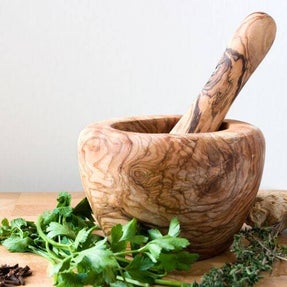
Medicinal Properties
- Expectorant: It contains mucilage and can be used to gently loosen and expel thick mucus
- Anti-inflammatory Properties: It is effective in reducing inflammation, especially of the respiratory system (your lungs).
- Demulcent: It creates a soothing coating over the mucus membranes much like a cough drop.
- Antioxidant: It binds to and protects the cells from free radicals.
- Flavonoids: In addition to being an anti-inflammatory and antioxidant, Broadleaf Plantain contains antibacterial, antiviral, antifungal, and anticancer properties.
- Wound Healing: Because Broadleaf Plantain contains anti-inflammatory, antibacterial, antiviral, and demulcent properties, it has been proven to be very effective in wound healing. In addition, it promotes tissue regeneration.

Current and Ongoing Studies
Several current and ongoing studies have proven the effectiveness of Broadleaf Plantain. Here are a few that are interesting:
- Antimicrobial and effective in wound healing: https://pmc.ncbi.nlm.nih.gov/articles/PMC10458736/
- Wound healing in mice: https://pubmed.ncbi.nlm.nih.gov/29575942/
- Reduced inflammation in Acetaminophen-Induced Liver Injury: https://pmc.ncbi.nlm.nih.gov/articles/PMC4537734/#sec5
- Strong antioxidant: https://pmc.ncbi.nlm.nih.gov/articles/PMC11240987/#sec4-ijms-25-07112
- Tissue repair: https://pmc.ncbi.nlm.nih.gov/articles/PMC6409144/#sec7
- Use of the seeds inhibited cancer cell growth in test tube studies: https://pubmed.ncbi.nlm.nih.gov/28839362/
- Cure stomach ulcers: https://pubmed.ncbi.nlm.nih.gov/21298726/
- Help to alleviate the symptoms of Inflammatory Bowel Disease: https://pmc.ncbi.nlm.nih.gov/articles/PMC4923812/
How to Use
Please Read:
Broadleaf Plantain has not been labeled as a GRAS (Generally Recognized as Safe) by the Food and Drug Administration (FDA). in 1997, several commercially sold Broadleaf Plantain products were contaminated with Floxglove. There are several current and ongoing studies regarding its effectiveness. If you have any pre-existing health concerns (especially respiratory or kidney) or are using any types of prescription medications or sedatives, it is always best to consult your doctor before use. Broadleaf Plantain is high in vitamin K, and can potentially interact with blood-thinning medications like warfarin. Some people may experience irritation to the skin or throat when using. If so, discontinue use immediately. Broadleaf Plantain is high in fiber. Large doses can cause diarrhea, vomiting, bloating, or gas. Although very rare, high doses can cause anaphylaxis. Women who are pregnant or breastfeeding should not use Broadleaf Plantain. Broadleaf Plantain is safe for children and should be used topically only and in specified amounts. Always use the recommended and proper dosing for each use. If you think you are having any reaction at all to the Broadleaf Plantain, discontinue use immediately and contact your doctor or healthcare provider immediately.

Tea
1 Cup Water, boiling
1 Tablespoon Dried Broadleaf Plantain Leaves
Honey and Lemon, optional
Mix ingredients in a small bowl and allow to steep for 10 minutes. Using a coffee filter or 2 to 3 sheets of cheesecloth, layered, strain the tea into a cup or mug. Alternatively, you can add leaves to a tea infuser, dip it into boiling water, and let it steep for 10 minutes.
Uses: Helps to soothe respiratory irritation, ease coughs, and alleviate symptoms of bronchitis due to its anti-inflammatory properties. Due to its astringent and anti-inflammatory properties, it can aid in diarrhea and other digestive issues. Support liver health, manage blood sugar levels, and potentially offer anti-tumor effects.
Adult Dosing: Begin with 1 cup of tea a day and build your tolerance up to no more than 3 cups a day.
Child Dosing: Although Broadleaf Plantain is considered safe for children, ALWAYS consult your doctor or healthcare provider before giving children under the age of 12 any herbal remedy. A rule of thumb for any herbal tea dosing for children is:
2 to 4 years -- 2 teaspoons
4 to 7 years -- 1 tablespoon
7 to 11 years -- 2 tablespoons

Poultice
"Spit" Field Poultice
Chew the leaf thoroughly to break down the plant's cell walls and release the medicinal properties.
Apply the chewed leaf directly to the affected area. Cover the poultice with a bandage or gauze to keep it in place. Change the poultice as needed, typically every few hours or when discomfort returns.
Traditional Poultice
Broadleaf Plantain Leaves, dried
Water
Grind dried leaves into a fine powder. Mix the powder with just enough hot water to create a thick paste. Apply the paste evenly on the affected area.
Cover the poultice with gauze, and if you'd like, cover the gauze with plastic wrap to avoid messes.
Uses: Soothe bug bites, stings, burns, and rashes. Draw out splinters, infections, and toxins, and promote wound healing.
Adult Dosing: Apply enough to cover the infected area adequately. Reapply as needed and use fresh gauze for each application. Most sites recommend reapplying every 30-60 minutes.
Child Dosing: Although Broadleaf Plantain is considered safe for children, ALWAYS consult your doctor or healthcare provider before giving children under the age of 12 any herbal remedy. Otherwise, you can apply in the same manner as Adult Dosing.
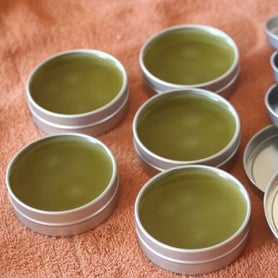
Salve
Start by Making a Plantain-Infused Oil
Equipment
1 32 oz Glass Mason Jar
1 Fine-Mesh Sieve
1 Funnel
1 Glass Jar for Storage
1 Lining – Coffee Filter, Cheesecloth, or Paper Towels
1 Pair of Food Grade Gloves
Materials
1 Cup Sunflower Oil
2 Cups Fresh Plantain Leaves
Cut the leaves into pieces and fill the Mason jar with the leaves.
Pour the oil over the leaves, ensuring everything is submerged. Top off with more oil if needed.
Find a cool, dark place, for your jar to rest for the next four weeks. This allows the oil to absorb the beneficial properties of the plantains.
During the first week, give the jars a good shake daily. This helps release the good stuff into the oil.
After four weeks, line a fine mesh sieve with either cheesecloth, a coffee filter, or paper towels. Strain the oil to remove the plantain material. Fold the lining material over the leaves, then press it with the bottom of a cup or jar to release every last drop.
Use a funnel to pour your finished oil into a clean jar for storage. Store in a cool, dry place for up to 12 months.
To Make the Slave
Equipment
1 Large Pot
2 Glass Jars (additional glass jars can be used to stabilize jars while boiling)
1 Funnel
Scale
Storage Containers
Materials
1 Cup Plantain Infused Oil
1 Ounce (by weight) Beeswax
Weigh out 1 ounce of Beeswax on a scale. Add Beeswax to a small jar.
Add 1 cup of Plantain Infused Oil to a second jar.
Boil Beeswax using the double-boiler method.
When the beeswax is almost done melting, add the jar of Plantain-Infused Oil to the Double Boiler for a few minutes to warm the oil. Mix the beeswax into the Plantain-Infused Oil and stir.
Using a funnel, pour the mixture into your containers and allow them to cool completely.
Place the lids on and store them in a cool place.
Uses: Soothe bug bites, stings, burns, and rashes. Draw out splinters, infections, and toxins, and promote wound healing. This can also be used for dry, chapped skin, and small cuts.
Adult Dosing: Wash the area with gentle soap and warm water. Dry thoroughly. Apply a thin layer of salve to the area and massage it in. Reapply as needed.
Child Dosing: Although Broadleaf Plantain is considered safe for children, ALWAYS consult your doctor or healthcare provider before giving children under the age of 12 any herbal remedy. Otherwise, you can apply in the same manner as Adult Dosing.
Add comment
Comments